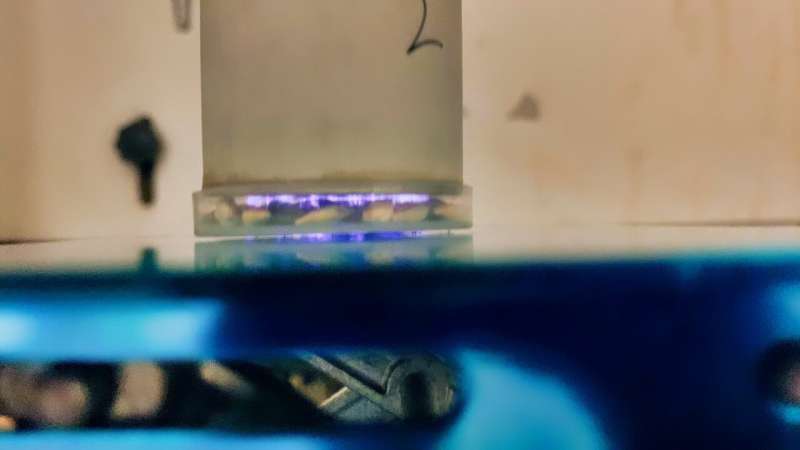This article has been reviewed according to Science X's editorial process and policies. Editors have highlighted the following attributes while ensuring the content's credibility:
fact-checked
trusted source
proofread
Cold plasma could be hot stuff for grain growers, say researchers

Using plasma—the stuff of outer space—University of Alberta researchers have found an effective way to decontaminate grain tainted by mold and also boost seed germination. Their study is published in the Journal of Food Engineering.
By treating wheat and barley grains with atmospheric cold plasma—a relatively low-temperature version of the typically superheated matter—they were able to lower the levels of harmful toxins caused by fungi that grow in warm, humid conditions and commonly infect grain.
The discovery "can provide the food processing and livestock feed industries with more effective, efficient ways to process grains that are safe for consumption," says Ehsan Feizollahi, who led the research to earn a Ph.D. in food science and technology from the Faculty of Agricultural, Life & Environmental Sciences.
Known as mycotoxins, the harmful secondary metabolites infect more than 25% of globally produced grains each year, including barley, wheat and oat grains in Western Canada, resulting in lower-quality crops and financial losses to farmers. They also pose threats to human and livestock health, including cancer, lung disease, brain and kidney damage, or even death.
Because mycotoxins resist high temperatures, removing them from grains is challenging, Feizollahi says.
"There is no effective method currently available for reducing mycotoxins on grain," he notes, adding that common food processing practices such as roasting, baking and frying may only partially remove mycotoxins.
"We needed to find better methods of decontamination."
Faster, better decontamination
In the field of physics, plasma is considered the fourth state of matter along with solid, liquid and gas, and has been attracting attention over the past few years, notes professor M.S. Roopesh, who supervised Feizollahi's work and studies the wider applications of atmospheric cold plasma through the U of A's Food Safety and Sustainability Engineering Research lab.
"As an emerging technology, cold plasma shows a lot of potential for reducing food safety risks."
Atmospheric cold plasma contains highly reactive components that deactivate or reduce the toxins on the surface of the grains.
Feizollahi created two forms of the plasma—one as an ionized gas and one as liquid—and then used them to treat barley and wheat grains infected with two mycotoxins that are particularly troublesome in Canada, called zearalenone and deoxynivalenol.
Using the plasma to decontaminate the grains lowered the levels of the two toxins by 54%, which is a promising start, Roopesh says.
"With optimization for the conditions, figuring in factors such as the type of plasma, treatment conditionals and treatment time, we could achieve much more reduction than 54%. Ultimately, that means farmers could use more of their grain, so there's less waste, and from the health point of view, humans and animals can consume the grain and not be affected by mycotoxins."
The researchers also found that the treatment processes they used took only a short time—ranging from one minute to one hour—potentially increasing efficiency for the food processing industry.
The treatments are also environmentally sustainable, Feizollahi notes.
"Making the cold plasma in gas form only requires air, and electricity required for the process can be drawn from renewable sources."
Nor does cold plasma leave residues on the grain, which eliminates the need for chemical sanitizers currently required in food processing.
"The plasma is highly unstable, so the reactive species in plasma disappear over the time when the plasma generation is stopped," Roopesh notes.
Win–win for barley and water
A plasma steeping technology the researchers developed could also be a key improvement for the barley malting industry.
Now going through the patent process, the cold plasma treatment gave a boost to the grain germination, which is used for malt and beer production, the researchers found.
Steeping the barley in plasma-activated water, rather than regular water, lowered levels of deoxynivalenol in the grain.
"If the malting operations fail to break down this mycotoxin, it can potentially transfer into the end products," Feizollahi notes.
The plasma-activated water also improved seed germination by 10% to 13% by changing its surface properties, leading to better water absorption, which can boost germination rate.
Along with that, the plasma has the side benefit of decontaminating the water used in the steeping process, which often contains traces of pesticides, bacteria or fungi.
Cleaner water could possibly be reused in food processing and would be more environmentally friendly when discarded, the researchers note.
The technology is open to licensing through the U of A, and next steps would involve more experiments to scale it up for use in the industry.
Feizollahi's experiments also revealed which factors increase the effectiveness of the treatments he tested, leading the way to further improvement.
"Now we know what specific factors we need to focus on," notes Roopesh, whose lab is also exploring how to scale up their cold plasma methods for use in reducing microbial contamination in food and water that can cause illnesses from bacterial pathogens like Escherichia coli and Salmonella.
"We've gained some foundational knowledge that represents an exciting step forward for food safety and for reducing agricultural product loss."
More information: Ehsan Feizollahi et al, Reduction of deoxynivalenol during barley steeping in malting using plasma activated water and the determination of major degradation products, Journal of Food Engineering (2023). DOI: 10.1016/j.jfoodeng.2023.111525
Provided by University of Alberta





















